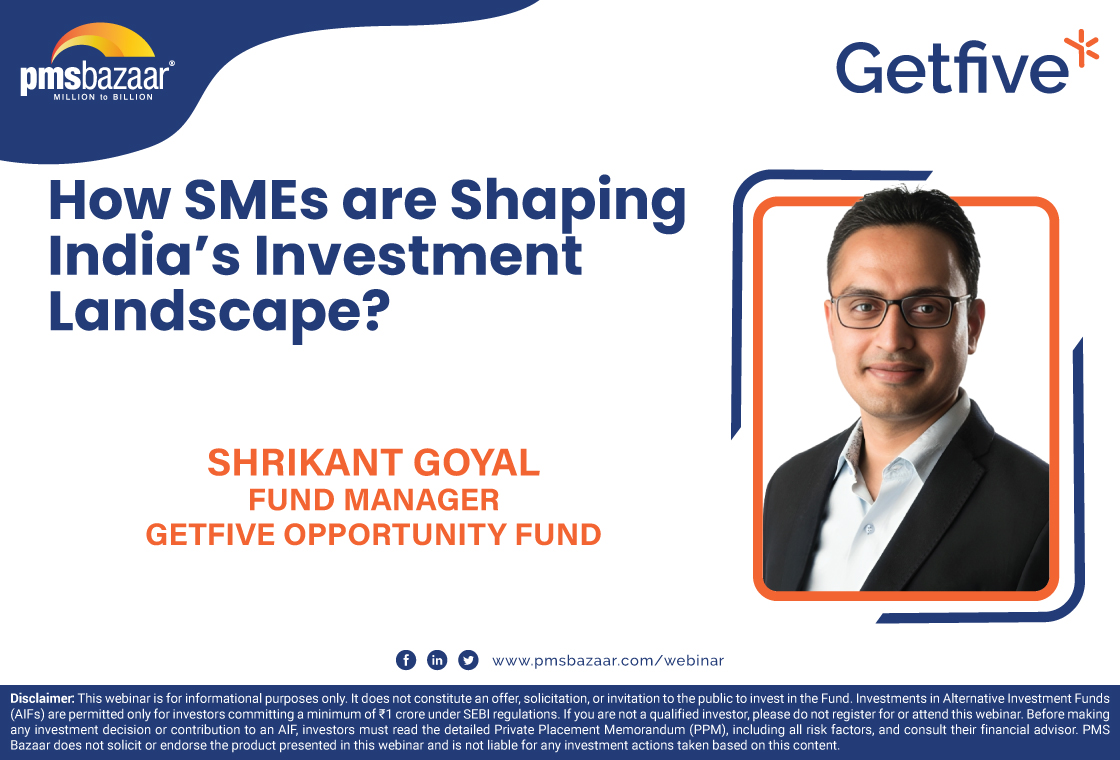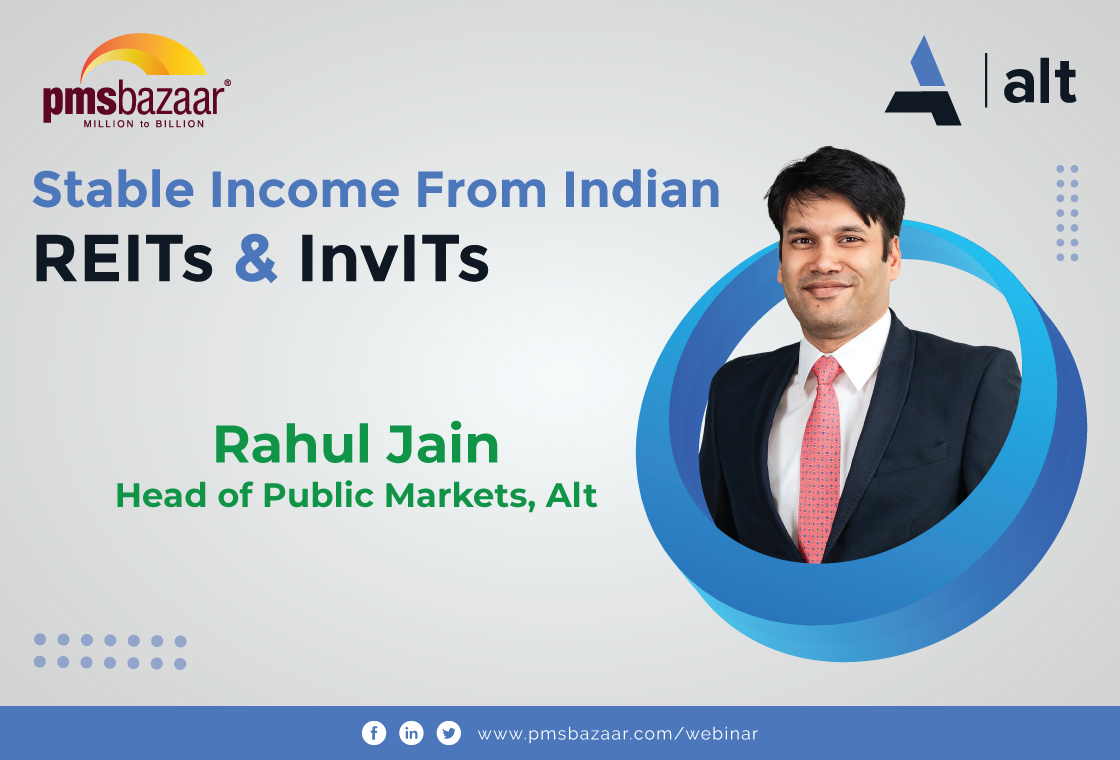The Indian economy has fully recovered to the pre-pandemic real GDP level of 2019-20, according to the provisional estimates of GDP released on May 31, 2022. Real GDP growth in FY 2021-22 stands at 8.7% which is 1.5% higher than the real GDP in FY 2019-20. These figures are associated with stronger growth momentum, indicating increased economic demand. India has emerged as the fastest-growing major economy in the world and is expected to be one of the top three economic powers globally over the next 10-15 years, backed by its robust democracy and strong partnerships. In this blog, we shall discuss India’s current market trend and how India is poised for robust growth, surpassing both emerging and developed markets

Considering India’s stupendous growth, PMS Bazaar conducted a webinar “Understanding the Market Trend - The Abakkus Way". The keynote speaker was Mr. Deven Sangoi, Senior Fund Manager, Abakkus Asset Manager LLP. Mr. Deven Sangoi dispelled investors’ perception and ambiguity of the market's state against the growing fear of recession in the United States. He discussed inflation, global concerns, and the cooling of commodity prices. He also gave a brief overview of the state of the market and discussed the robustness of the Indian economy and how well-positioned India is to withstand shocks from the outside world and go forward.
The key insights covered in this webinar blog are
- Current market situation
- India v/s global markets
- Broader markets have underperformed
- Current concerns-Inflation & Interest rates
- Major concerns
- Sharp prices in commodities have started to cool off
- India relatively well placed
- India's size of the opportunity
- Rural economy growth
1. Current market situation
The market had a dream run the previous two years, however in the current year, there had been significant volatility, and hence, concerns related to the market had begun to surface. There was a significant correction in the NIFTY, and with corrections in the global markets, any hype and euphoria from the previous two years had been transformed into fear and apprehension about inflation.
As the Central Banker removed the liquidity from the system that had been infused during the COVID crisis, everyone's concern was focused on the interest rate hike that Fed may decide on, how quickly it would come, how long it would continue, and how would India respond. Interest rates will increase significantly in the future, and there would be further steep cuts. According to Mr.Deven, “However, India has, so far, reacted very positively with the government resorting to several measures to reduce the inflation rate. Some of these measures are cut/reduction in excise and customs duties on crude and group products, and a ban on the export of wheat and sugar, among others.”
2. India v/s global markets
India has been one of the best-performing markets over the past year and the past three months, and the Nasdaq almost drop below the pre-COVID level. Many prominent companies experienced declines of between 70 and 90 percent.



There was a lot of gloom on the Nasdaq, and global markets corrected sharply in response to these concerns. However, comparing the NIFTY and the MSCI emerging market, the MSCI EM declined by 19%. Whereas Indian equities declined by only 7%. Therefore, India is doing relatively much better than the other emerging markets and the U.S developed market.
3. Broader markets have performed

During the Covid crisis, there was a very sharp increase in upcycle mid-caps and the broader market had done much better than NIFTY. Similarly during the downturn, small- and mid-caps have corrected more than the NIFTY, which are the larger indices.
4. Current concerns: Inflation/interest yield
On the inflation front, inflation has risen in India, with the WPI rising faster than the CPI. The most recent US inflation was almost 9%, but for India, it was a little lower at 8.5%.

With higher inflation, there was a huge sell-off in the bond market. Hence, both India's and the United States' global bond yields increased.
5. Major Concerns
Concerns began with inflation, then with geopolitical risk. According to Mr. Deven, “The Ukraine-Russia war resulted in a lot of negative news and increase in oil prices. However, today if you look at the last couple of months, though the war is still going on, there is no hue and cry and the media does not cover the news on the front page. Hence, a large part of negative news is getting discounted.”
Where higher oil prices were concerned, people were predicting oil prices could rise from 150 dollars to 200 dollars. However, with the tightening of measures, which slows down the global economy, crude cannot sustain and crude has corrected from highs of 120s to now mid-90s The next concern is commodity prices. Commodity prices have gone into a parabolic rise and they will continue to rise. The global economic growth will, however, bring down the commodity prices
Rising interest rates have spiked inflation, however, as inflation starts cooling off from the peak, as the commodity prices and crude oil prices fall, and global economic growth slows down, there would be benign inflation or rate hikes. For example, the gas price, which was nearly six dollars, has now dropped to four and a half dollars per gallon.
The next concern is FII selling. FII selling has seen record FII selling almost close to GSC times, and despite this, when GSC occurred, the market collapsed by 40 percent. With similar selling this time, the market is down by 17 to 18 percent, and the majority of the selling was completely absorbed by domestic flows, which have been extremely strong throughout this volatility.
Concerning Indian rupee depreciation, Indian rupee depreciation is not out of sync, and India continues to be one of the best currency-performing. There are currencies of other countries that have depreciated by almost 30 to 50 percent. Hence, the Indian rupee is much stronger and there is not too much to worry about as we continue to witness a relatively weaker rupee.
6. Sharp prices in commodities have started to cool off
In terms of commodities, we have seen significant increases in everything from coal to crude cotton to raw sugar, but they have begun to cool off. Wheat prices, which have also increased significantly, post the Ukraine war has begun to cool off. With the export ban imposed following the Ukraine war, wheat prices have fallen.


Steel prices have also been corrected with the slowing of global growth, and the copper price, which is a leading indicator of global industrial growth also corrected significantly from the top.
7. India is relatively well-placed
If you look at the job market today, India is relatively well placed. Mr. Deven stated that “We have seen a very good demand environment and a very strong revenue outlook from the industry, though there have been margin pressures with select industries, overall with the current scenario, we've seen this season that there has been an upside surprise. We expected a lot of margin pressures everywhere, but they haven't been significantly negative. Because very few companies reported results that were significantly lower than expected.”
India remains the fastest-growing economy. The government revenue collection, whether it is income tax or GST collection, is at an all-time high. The market is now trading at a reasonable valuation, and the resilience that India has shown right from the investor to the economy shows that India is in a different league and is a different country relative to global growth.
India is not a domestically dependent economy, and exports show very good strength as a number of factors are positively impacting, such as China plus one, India gaining market share, and Indian entrepreneurs’ hard work getting reflected in good export performance. Therefore, India has become a very notable manufacturing base.
8. India's size of the opportunity
India has risen to fifth place in terms of market capitalization, and while the rupee's depreciation has narrowed the gap, it remains that India has performed significantly better, and no one can deny that. India’s market cap has the fastest growth. In terms of market capitalization to GDP, it is significantly higher than its peers' domestic demand.

If you look at the GST collection, the tax collection, the manufacturing PMI, the IIP growth, and the CV sales, all of these indicators show a good revival and buoyancy. India's overall macroeconomic position is very favorable, with a very strong balance sheet to support growth. The current account is also in good shape, even though we have lost some of our forex reserves, we still have more than ten months of import tower, which is very strong.
The UD/INR depreciation is again in line and the other important factor is that our IT exports are at an all-time high and higher than our current deficit. Therefore, the current account is very strong and India also has witnessed strong FDI flows, which is nearly 83 billion dollars year-to-date. Surprisingly, India is a consumption-driven economy with good manufacturing-led exports and, aside from IT exports and chemical exports, other manufacturing exports are picking up.
9. Rural Economy
Last but not least, the real rural economy has done significantly better in the last two or three months, and India has seen a very strong recovery taking place, partly due to the good monsoon, partly due to government spending, and partly due to relatively high aggregate prices.

India has seen high corn prices, reasonable increases in wheat prices, and policies on the ethanol front have given a fillip to the sugar belt, both sugar and ethanol economies are doing exceptionally well. Hence, the net rural economy is in very good shape and is recovering fairly quickly. On the manufacturing side, India has seen a slew of initiatives from the government that is giving a fillip to manufacturing.
One is the “Make in India” scheme, and then we had the PLI scheme, corporate rate tax cut, which made India competitive in terms of the overall Asian economy, and overall focus on increasing the logistic or availability of infrastructure for sustaining manufacturing and manufacturing export, has made India very strong and replacement ground for against China.
Mr. Deven Sangoi discussed the above topics in detail and also answered questions from the audience towards the end of the session. For more such insights on the subject, watch the recording of this insightful session through the appended link below:
Get access to rich data and analytics of PMS & AIF by subscribing to us. Join the 40000+ investors & experts now: Subscribe NOW
Disclaimer: The Data points/ Graphs, information & opinions shared in this blog are not and should not be construed as an offer or solicitation to buy or sell any securities/Investment products. No Material/information provided in this blog should be construed as investment advice. Any Action on your part on the basis of the content mentioned in this blog is at your own risk and responsibility.
The coverage of views & opinions shared by our guests and the product presentations (if any) in this webinar blog does not imply an endorsement of AMC or its products by PMS Bazaar.
For a detailed disclaimer and terms & conditions - Click Here
Recent Blogs

MICRO CAPS: The Dark Horses of the Indian Equity Market
PMS Bazaar recently organized a webinar titled “MICRO CAPS: The Dark Horses of the Indian Equity Market,” which featured Mr. Rishi Agarwal and Mr. Adheesh Kabra, both Co-Founders and Fund Managers, Aarth AIF. This blog covers the important points shared in this insightful webinar.

Finding Clarity in Volatile Markets: A Large-Cap Led ASK CORE Strategy
PMS Bazaar recently organized a webinar titled “Finding Clarity in Volatile Markets: A Large-Cap Led ASK CORE Strategy,” which featured Mr.Anunaya Kumar, President – Sales and Distribution ASK Investment Managers Limited. This blog covers the important points shared in this insightful webinar.
.jpg)
Passively Active Investing — A Modern Investor’s Lens on ETF-Based PMS
PMS Bazaar recently organized a webinar titled “Passively Active Investing — A Modern Investor’s Lens on ETF-Based PMS,” which featured Mr. Karan Bhatia, Co-Founder and Co-Fund Manager , Pricebridge Honeycomb ETF PMs. This blog covers the important points shared in this insightful webinar.

Spot the Trouble: Red Flags in Equity Investment Analysis
PMS Bazaar recently organized a webinar titled “Spot the Trouble: Red Flags in Equity Investment Analysis,” which featured Mr. Arpit Shah, Co-Founder & Director, Care Portfolio Managers. This blog covers the important points shared in this insightful webinar.

Long-Only AIFs Rebound Sharply in October; Long-Short Strategies Lag Despite Lower Volatility
106 long-only AIFs averaged 3.68% vs 32 long-short AIFs at 2.7%; only 24–31% of funds beat key indices

Markets log strongest monthly gains in 7 months; PMS performance turns near-uniform in October
Nifty 50 TRI gained 4.62%, BSE 500 TRI rose 4.27%; 415 of 427 equity PMSes ended positive

How SMEs are Shaping India’s Investment Landscape?
PMS Bazaar recently organized a webinar titled “How SMEs are Shaping India’s Investment Landscape?” which featured Mr. Shrikant Goyal, Fund Manager, GetFive Opportunity Fund.

Stable Income from Indian REITs and InvITs
PMS Bazaar recently organized a webinar titled “Stable Income from Indian REITs and InvITs,” which featured Mr. Rahul Jain, Head of Public Markets, Alt.

